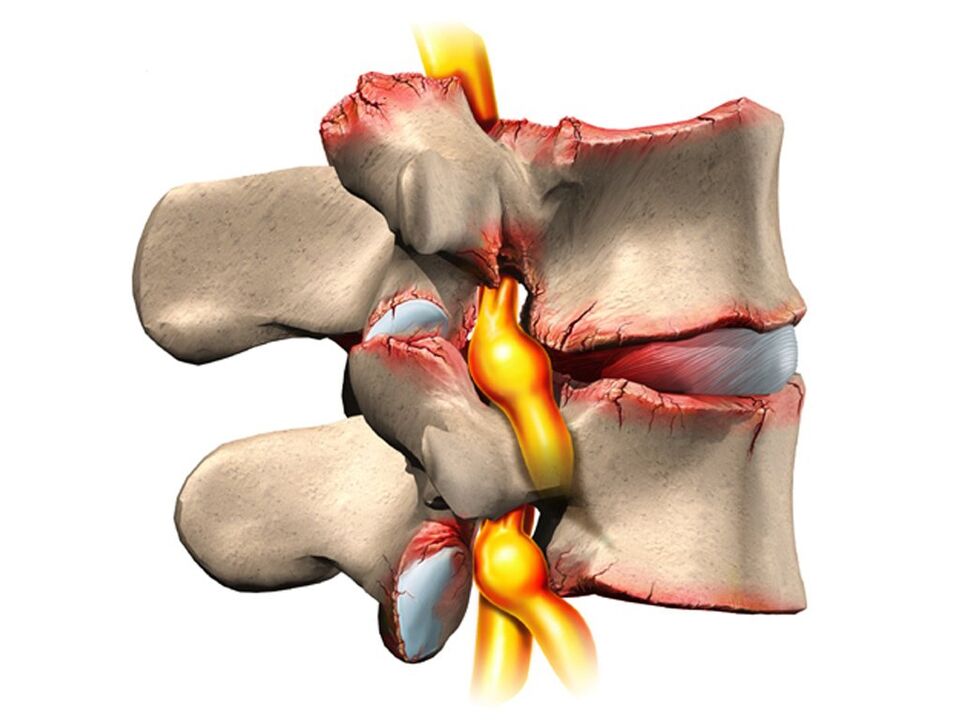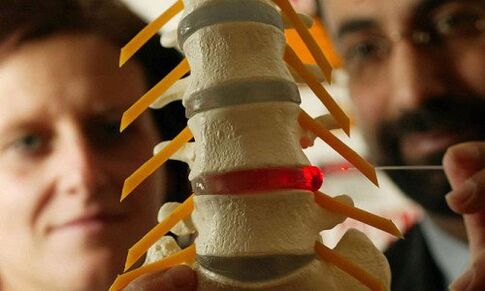
The term osteochondrosis itself is derived from two words: osteo - bone and chondri - cartilage. Simply put, this is cartilage ossification. Although this interpretation is fundamentally wrong. Some go even further in their illusions and are convinced that osteochondrosis is the deposition of salts in the joints. Moreover, it is table salt that is likely to be consumed in large quantities for food.
Pathogenesis
In fact everything happens a little differently. And more difficult. Even table salt, if it plays any role in the development of osteochondrosis, is very indirect. Osteochondrosis underlies the degeneration and degeneration of articular cartilage. It is not an independent disease but a pathological process that can be observed almost everywhere where there is connective tissue.
Nevertheless, osteochondrosis in most cases affects the spine. ᲠWhy is that? The fact is that there is a kind of cushion between the vertebrae - the intervertebral discs. The physiological role of these discs is to charge the vertebral bodies and protect them from premature wear due to mechanical stress. The disc consists of an inner fluid nucleus surrounded by a ring of fibrosis and an upper and lower end plate.
The disc experiences enormous mechanical stress, causing permanent damage to its structures at the cellular level. In humans, these processes are very pronounced - this is our pay for walking upright. If the disc is not completely "erased", it must be constantly restored, ie it must restore itself. It is the balance of damage-regenerative processes that determines the normal structure of the intervertebral disc. Another interesting detail is that the intervertebral discs are supplied with blood and nutrientsNot with excessive blood vessels in childhood, but diffusely, from the bony tissue of the vertebral bodies. Again the ability to move on two limbs and not on four.
Because of this, the intervertebral discs are easily damaged anatomically and physiologically. Any negative process in the body leads to an imbalance of damage-regenerative balance, the development of dystrophy and degeneration in the discs. A structurally defective disc can no longer withstand proper mechanical stress. Under excessive pressure on the roofed spine, the discs move in different directions, usually to the sides and back. This process is called a disc herniation.
The bone tissue of the spine, which has lost its cartilaginous membrane, also experiences mechanical wear. Permanent trauma to the surface of the anterior edges of the vertebral bodies results in the formation of abnormal bone formations - osteophytes. Spondylosis develops. Due to the degeneration and displacement of the disc, the intervertebral spaces shrink, the spinal canal narrows, and the roots of the spinal nerves e. g. წ.
ᲛReasons
The causes or etiological factors of osteochondrosis are various. They can be due to local or spinal pathology, as well as general disorders at the organism level. Osteochondrosis can be caused by any pathology that leads to a disorder of the structure of the spine or metabolic disorders. In this regard, there are:
- Changes in the configuration of the spine (scoliosis, abnormal lordosis or kyphosis).
- Other defects of the musculoskeletal system are flat feet, narrow shoulder girdle, abnormalities in the structure of the pelvis.
- Spinal cord injury.
- Weak immunity.
- Metabolic disorders - osteoporosis, obesity, diabetes, thyroid disease.
- Diseases of the cardiovascular system - atherosclerosis, hypertension.
- Digestive disorders leading to insufficient absorption of nutrients from the gastrointestinal tract.
- Inheritance.
It should be noted that the above pathological conditions do not necessarily cause osteochondrosis. This requires the constant exposure to certain predisposing factors - hypothermia, poor nutrition, seductive lifestyle or, conversely, excessive physical activity.
Symptoms
Osteochondrosis itself is an asymptomatic process. And, at the same time, the signs of intervertebral disc degeneration are varied. How? The fact is that the clinical manifestations of osteochondrosis are based on its complications - disc herniation, spondylosis, sciatica, narrowing of the spinal canal.
Moreover, the clinic is highly variable according to the predominant localization of the process in the cervix, thorax, or lumbosacral spine. The last section is most often injured because it is the lower part of the spine that receives maximum physical activity. Signs of osteochondrosis of the lumbosacral region:
- Pain (lumbodinia, lumbago, sciatica).
- Restriction of movement in the spine and lower extremities (intermittent claudication).
- There are paresthesia-type sensitivity disorders - numbness, burning, crawling alive.
- Abnormal tension in the lumbar muscles.
- In the absence of treatment, dysfunction of the pelvic organs.
Osteochondrosis of the cervix is observed somewhat less frequently than lumbosacral. However, this pathology is also quite common. In addition to the typical signs of pain (cervicalgia), hypersensitivity and movements in the upper extremities, cervical osteochondrosis due to impaired blood supply to the brain has its own characteristics. These qualities are revealed:
- Insomnia.
- Headache, dizziness.
- Periodic nausea.
- General weakness, rapid fatigue.
- Blood pressure fluctuations.
- Sometimes toothache.
- Behavioral reactions in the form of tears, irritability.
The thoracic region with osteochondrosis is relatively rarely injured. Patients in this case are individuals who are forced to sit in a fixed uncomfortable posture by profession - students, schoolchildren, programmers, office workers. The symptoms of osteochondrosis in this case will be as follows:
- Pain and paresthesia in the chest.
- Shortness of breath.
- Feeling of heartbeat.
- Restriction of movement in the thoracic spine.

Diagnosis
From all this it is clear that osteochondrosis is a disease of the chameleon. Due to the similarity of the signs, it is easy to confuse it with cerebrovascular accident, hypertension, myocardial infarction, angina, neurotic disorders. That is why a comprehensive complex diagnosis is necessary to make a correct diagnosis, to correctly diagnose the symptoms and treatment of osteochondrosis.
This diagnosis, in addition to traditional interrogation and clarification of patient complaints, should include medical examination and special research methods. These methods include x-rays of the spine, ultrasound of internal organs. Recently, computed tomography and magnetic resonance imaging have been used successfully to diagnose osteochondrosis.
Treatment
Therapeutic tactics for osteochondrosis include:
- Drugs.
- ᲛMassage.
- Physiotherapeutic procedures.
- Physiotherapy (exercise therapy).
- Manual therapy.
- Acupuncture.
Osteochondrosis medication is mainly aimed at relieving pain and inflammatory processes in the nerve roots. In various combinations these drugs are widely used in the form of ointments, injections, tablets for the treatment of osteochondrosis. Do not forget that these drugs adversely affect the liver, stomach and intestines. Thus they can aggravate metabolic disorders during osteochondrosis. They well relieve blockade pain with local anesthetics. It is true that the effect of these joints is short-lived and in no way affects the course of osteochondrosis as a whole.
It is possible to improve metabolic processes locally and at the body level with the help of drugs such as chondroprotectors, immunostimulants and vitamins with minerals. Chondroprotectors are used in tablets, ointments and ampoules. Among the tonics used are vitamins C, B group, along with minerals. In this regard, calcium supplements are most preferred. Indeed, contrary to some misconceptions, the basis of osteochondrosis is not excess, but only calcium deficiency.
After successful removal of the exacerbation, physiotherapy procedures, massage, and exercise therapy are indicated. As physical procedures are used electrophoresis with calcium, phonophoresis with hydrocortisone, amplipulse, paraffin therapy. All these measures are aimed at eliminating pain and inflammation in the nerve roots, ligaments and muscles. Osteochondrosis massage is performed according to a generally accepted method. The massage zone is selected according to the localization of osteochondrosis. Extending the range of motion is achieved with the help of exercise therapy. In the beginning, in the aggravation phase, there are practically no dynamic loads. The patient is constantly in an optimal posture. At this time it is desirable to wear immobilization tools - waist corset, shank neck collar. As the aggravation decreases, so does the volume and duration of movements during exercise therapy.
Recently, non-traditional methods of treatment have been adopted for the treatment of osteochondrosis - acupuncture, manual therapy, osteopathy. Acupuncture is the effect on special biologically active points located along the spine, auricles, hands and feet. With manual therapy, the normal condition of the vertebrae and intervertebral discs is restored by the hand of a specialist. And in osteopathy, the structural integrity of the musculoskeletal system is ensured using specific techniques. In the absence of effect of conservative measures in the treatment of osteochondrosis, persistent pain, complications, surgery is indicated. The abnormally displaced disc is removed. Microdiscectomy - endoscopic removal of a displaced disc - is currently performed for this purpose.

















































